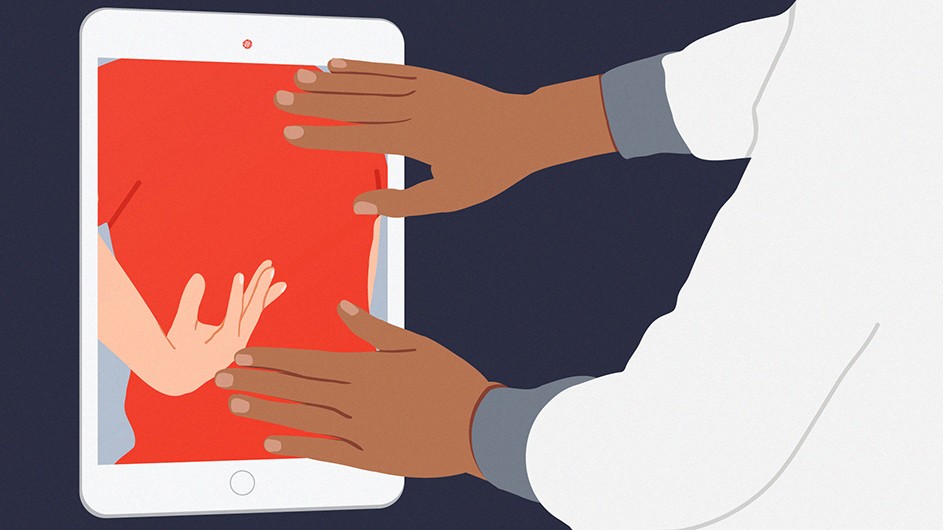Human Body as Teacher
Virtual classes can teach future physical therapists important skills, but only through human touch do hands learn to feel and see.

This is part of a Columbia News series, titled Lessons Learned, which invites the Columbia community to reflect on the pandemic and the insights they have gained from their COVID-19 experience. These essays speak to the innovation, creativity and resourcefulness we have witnessed during this period of unprecedented challenge, as well as some of the silver linings in the actions we have had to take by necessity.
In March, Columbia’s programs in physical therapy transitioned from in-person classes to online. With students pulled from their clinical placements and lab classes cancelled, faculty were challenged by the seemingly impossible task of transforming “learning by doing” into “learning by watching and discussing.”
I teach in the physical therapy program at Columbia’s medical center and was halfway through my course on the kinesiology and biomechanics of gait when COVID-19 hit.
I knew right away that the class would have to miss out on acting out gait case studies, which give PT students the opportunity to work in teams to observe, diagnose and simulate movement and pain conditions demonstrated by volunteers. The activity is important in building clinical skills, and students enjoy the challenge of puzzling out the nature of a physical problem based on what they are feeling and seeing.
The activities are always exciting to watch: everybody up and moving, simulating a drop foot and steppage gait or swaying side-to-side (a gait deviation that helps reduce muscle demand on osteoarthritic hips). The teams debate and modify their movements after "feeling them out" before taking the stage to present them to the class.
I was not able to replicate these demonstrations in the wake of COVID-19. Instead, I spent hours curating an expanded library of videos to watch and discuss via Zoom. Although I felt the loss, pedagogically, video analyses of gait presentations and musculoskeletal injuries proved to be comparable replacements. Students embraced the virtual learning environment and thrived during this component of our curriculum. But for many other courses, hands-on learning could not be replaced and lab classes were postponed.
Spring is when our first-year doctor of physical therapy (DPT) students are learning and practicing safe transfer techniques and bed mobility. Lab classes include practice with assistive devices and gait training on stairs. Students learn to coordinate their instructions, handling and body mechanics to ensure their own safety as well as the safety of the patient, critical skills to master before we send them out to hospitals, rehabilitation centers and nursing facilities for clinical education.
In the orthopedic courses, hands-on psychomotor skills are essential for the assessment of movement impairments and interventions.
Students in their first year have not had any of their orthopedic labs because of the move to virtual classes. Our second-year DPT students missed the opportunity to expand their clinical laboratory skills. We postponed orthopedic labs covering the thoracic and cervical spine. Some courses could not be taught during our summer semester because of their emphasis on lab instruction.
The lab is an environment where students learn traditional massage techniques, trigger point therapy, myofascial and soft tissue manipulation, joint mobilizations and special tests. In these labs, the hands learn to “feel and “see.” These are not skills that can be developed and practiced virtually.
This realization did not surprise our faculty. In the world of PT, our signature pedagogy is the human body as teacher. It is essential in our profession to provide students with opportunities to practice skills with experienced mentors before they work with patients.
As we look ahead to the fall, many health professions programs at Columbia will stay online. Our didactic, discussion-based instruction will remain in hybrid form online as well.
We are working with the University, however, to conduct in-person labs and clinical experiences and have developed a plan that includes donning face masks, shields and gloves. Lab partners would stay the same all term. We are preparing to teach labs three times each to accommodate greater distancing and smaller lab groups.
It has been an important time for all of us to reflect on what we teach, how we teach and what’s most critical in the education of future physical therapists. What we’ve learned from COVID-19 is guiding our plans.
Laurel Daniels Abbruzzese is an assistant professor of Rehabilitation and Regenerative Medicine (Physical Therapy) at Columbia University Irving Medical Center and director, Performing Arts Fellowship.